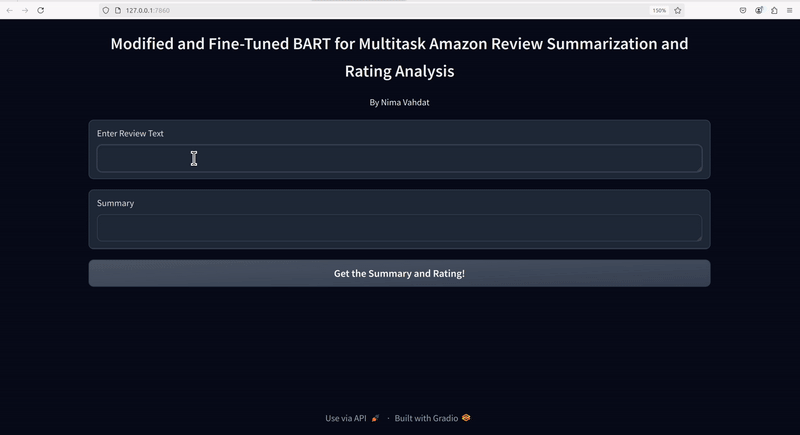This project leverages a fine-tuned BART model to perform multitask learning for Amazon review summarization and rating prediction. The model is designed to generate concise summaries of review texts and predict ratings based on the provided content. To enhance training efficiency, Hugging Face's Accelerate is used for distributed training, enabling multi-GPU support and mixed-precision training.
- Model Training: Fine-tuning BART for multitask learning using an Amazon review dataset. Distributed training is handled by Hugging Face's Accelerate to scale across multiple GPUs.
- Inference API: A Flask-based API integrated with a Gradio interface for easy review submission and result display.
- Web Interface: A user-friendly web interface to interact with the Gradio app embedded in a Flask web page.
- Summarization: Generates a concise summary of the review text.
- Rating Prediction: Predicts the rating (1-5 stars) based on the review content.
- Web Interface: Integrated Gradio app for real-time interaction.
- API: Flask API endpoint for programmatic access.
- Distributed Training: Hugging Face's Accelerate is used to efficiently train the model on multiple GPUs with mixed precision.
Here's a demonstration of the Gradio app in action:
-
Get Dataset: Please review this and then update your data configuration file.
-
Configuration Files: Create and update your configuration files for data and training settings. Example files can be found in the
config/directory. -
Run Training Script:
python train.py
This script will use the configurations specified in your YAML files to train the BART model and save the best-performing model.
-
Start the Flask Server:
python app.py
This command will start the Flask server, which includes the Gradio interface for interacting with your model.
-
Access the Web Interface: Open your web browser and navigate to
http://localhost:5000to view the Gradio interface embedded within the Flask application.
You can also interact with the model via the Flask API. Here is an example of how to use cURL to get a summary and rating:
curl -X POST http://localhost:5000/predict -H "Content-Type: application/json" -d '{"review_text": "Your review text here"}'Response Example:
{
"summary": "Generated summary of the review text.",
"rating": 4
}train.py: Script to train the BART model with specified configurations.app.py: Flask application integrating the Gradio interface.model.py: Contains the BART model definition for review summarization and rating.templates/index.html: HTML template for embedding the Gradio interface.config/data_info.yaml: Configuration file for data-related settings.config/training_info.yaml: Configuration file for training-related settings.
transformers: For model and tokenizer.torch: PyTorch library for deep learning.flask: Web framework for building the API.gradio: Interface for interactive model deployment.pyyaml: For reading configuration files.
This project is licensed under the MIT License. See the LICENSE file for details.
